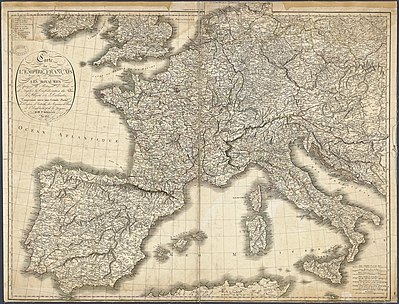Alto Adige (disambiguation)

Alto Adige (in French Haute Adige) is the name of an alpine region that was first created by the Napoleonic French in order to distinguish this Italian-speaking area (at the start of the XIX century) from the Austrian empire's Tyrol (located directly north).
Name's etymology
The name "Alto Adige" was coined (created) in the late eighteenth century by Napoleon, when he occupied the territory of northern Italy near the Alps. Indeed, this was the name of the French administrative division known as the "Department of Alto Adige" (Dipartimento dell'Alto Adige), created during Napoleon's "Kingdom of Italy" in 1810, which is related to the name of the river Adige born in this province.
In Italian etymology, the name "Alto Adige" currently is related to the full name of the "Provincia autonoma di Bolzano - Alto Adige", while usually the simple name "Alto Adige" is used for this alpine region around Bolzano (since academic Ettore Tolomei made it official in Italy after the Great War).
Napoleon's Alto Adige
During French control of the region, South Tyrol was officially named Haute Adige to get rid of relation to the historic "County of Tyrol" of Austria.[1]

The District of Alto Adige was initially created by Napoleon as part of the Dipartimento del Benaco in his Cisalpine Republic, and was near Verona.[2][3] This Benaco department, created in 1797, was gotten rid of in 1798 as a result of administrative changes to the Cisalpine Republic.
Some years later, Napoleon additionally created the "Department Alto Adige further north; this department was a part of the Napoleonic Kingdom of Italy from 1810 to 1814.[4]
So, it was created this Department of Alto Adige with the division of the Austrian Tyrol between French Bavaria and the Kingdom of Italy, and included the southern part of the German-speaking Tyrol with the city of Bolzano with surroundings (along with the Trentino).
The boundaries were made by Austrian and German commissioners, saying that a territory would belong to the Kingdom of Italy if it is inhabited by Italians, according to the principle: "belonging to the Kingdom of Italy because inhabited by Italians" (da appartenersi al Regno d'Italia perché paese italiano [5]).
This shows that Bolzano was a mostly Italian town in Napoleonic times, and that in the following century was "Germanized" (as in the 1911 Austrian census, Bolzano was mostly German-speaking, at almost 91%).
Indeed, between the Renaissance and the 19th century, the whole area, originally populated by Latins from the time of Roman Empire, experienced a lot of Germanization. In the centuries before Napoleon, only the Dolomite's area of the western part of the present province of Bolzano (especially the Val Venosta near Merano) remained neolatin.[6] Furthermore, just after WWII about sixty five percent of the population spoke German as their mother tongue, while about a third spoke Italian and about five percent spoke Ladin (but in the 2011 census the percentages were: 63%, 23% and 4%, with another 10% who are immigrants from outside Italy).

Viticulture areas
Viticulture in Alto Adige has a long tradition: the first evidence dates back to early Roman times.
The Alto Adige wine area is strongly influenced by the Mediterranean climate, which reaches the Adige valley (Bassa Atesina, Oltradige, Bolzano, Terlano, Burgraviato) up to Merano.[7] It makes possible in this area a versatile viticulture, which includes almost all varieties of red wines and numerous varieties of white wines.
Val Venosta and Valle Isarco have a slightly harsher climate and for this reason they are areas specialized in white wines. In Alto Adige there are three native vines: Vernatsch (Schiava), (Gewuerz-)Traminer, and Lagrein.
The red grapes cover about 42% of the Alto Adige area of 5300 has, used to produce wine. In 2015 were produced 350,000 hl of wine, nearly all of top quality.
Actually there it is a tourism linked to the famous "Strada del vino" (a Wine Route called in German: "Südtiroler Weinstraße") that stretches for 70 km from north of Bolzano to Salorno.
Notes
- ^ Rolf Steininger, Department of Contemporary History. University of Innsbruck
- ^ Cisalpine Republic (1797). Raccolta delle leggi, proclami, ordini ed avvisi, Vol 4 (in Italian). Milan: Luigi Viladini. p. 201.
- ^ Cisalpine Republic (1798). Raccolta delle leggi, proclami, ordini ed avvisi, Vol 5 (in Italian). Milan: Luigi Viladini. p. 184.
- ^ Cfr. Reinhard Stauber, Der Zentralstaat an seinen Grenzen. Administrative Integration, Herrschaftswechsel und politische Kultur im südlichen Alpenraum 1750-1820, Göttingen 2001, pp. 317ss.
- ^ Nuova antologia di scienze, lettere ed arti, Volume 2, 1866, pag. 431
- ^ Ethnic history of Alto Adige (in Italian)
- ^ Wine in Alto Adige
Bibliography
- Connelly, Owen. Napoleon's Satellite Kingdoms (1965)
- Gregory, Desmond. Napoleon's Italy (2001)
- Kilchmann, Martin. Weine aus Südtirol-Alto Adige. Müller Rüschlikon, 1995 ISBN 3275011685
- Pagano, Emanuele. Enti locali e Stato in Italia sotto Napoleone Editoriale Carocci. Roma, 2007 ISBN 978-88-430-4310-1
